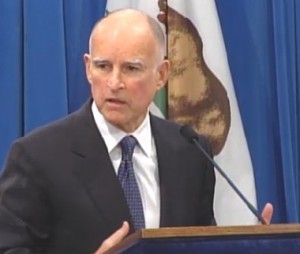More California voters favor than oppose Gov. Jerry Brown’s sweeping plan to reform school finance, and most are against the idea of lowering the threshold for approving local school parcel taxes from two-thirds to a 55 percent majority, according to a new statewide poll.

Gov. Jerry Brown
An even 50 percent of respondents told pollsters they favored – while 39 percent opposed – the idea of having “some money diverted from middle and upper class children to low income children and English language learners.” That’s a key element of the Local Control Funding Formula for schools that the governor is proposing to phase in over the next seven years. Brown plans to use increased revenue from Proposition 30, approved in November, and the growth in state revenues, and he adds the caveat that, in shifting resources to needy children, no district will receive less money than it currently spends.
Results of the USC Dornsife/Los Angeles Times Poll of 1,501 registered voters broke down along economic and ethnic lines, with those whose children would likely benefit being more supportive of Brown’s plan.
“There’s a real dividing line. ‘What’s in it for my kids?’ is probably what the divide is,” said Drew Lieberman, vice president of the Democratic polling firm Greenberg Quinlan Rosner, which conducted the poll, in a statement. Of those who make less than $50,000 per year, 63 percent back the plan, while 45 percent of those earning more than $50,000 and 42 percent earning more than $100,000 like it. Latinos favored it 67 percent to 26 percent opposed, while 42 percent of whites said they support the plan with 46 percent against it.
The lukewarm backing of Brown’s plan in the poll, released on Sunday, differs from findings of a January poll conducted by the Public Policy Institute of California of 1,704 adults, not just registered voters. That poll found significant support for the funding proposal – and proved that phrasing matters. While the USC Dornsife/Los Angeles Times wording mentioned “diverting” money from wealthy to poor students, PPIC’s question asked, “Governor Brown’s budget plan includes new K–12 school funding that will mostly go to local school districts that have more English language learners and lower income students. Do you favor or oppose this proposal?” Seventy-five percent said they supported it, 21 percent opposed and 3 percent said they didn’t know.
Here are the responses to the USC Dornsife/Los Angeles Times questions on the parcel tax (#19) and the Local Control Funding Formula (#20). The columns, from left, are strongly favor, somewhat favor, somewhat oppose, strongly oppose, don’t know (DK) and refused for all respondents (top line), white and Latino voters. (Click to enlarge)
“There is a lot of public support in investing in vulnerable kids. It depends how the question is framed,” said Samantha Tran, director of education policy for Children Now, an Oakland-based advocacy organization that favors Brown’s proposal.
The other key element of Brown’s Local Control Funding Formula is to give local districts more control over how education dollars are spent. Many of the state rules dictating specific spending in areas like school bus transportation, vocational training and summer school – those specified in the USC Dornsife poll – would be rescinded. USC Dornsife found 59 percent supported giving districts more flexibility, with 31 percent opposed. PPIC phrased the question differently, asking whether voters had confidence school boards, given more control, would “use this money wisely.” Seventy-one percent said they were very or somewhat confident school boards would do so, while 30 percent said they had little or no confidence in their local boards to make the right calls.
Brown has proposed the new financing plan as part the 2013-14 budget, which legislators will vote on before July 1. Voters won’t have a direct say in the outcome, although their legislators, particularly those in suburban and wealthy districts, will be listening to constituents.
Voters, however, may get a say over a 55 percent threshold for passing a parcel tax, if two-thirds of legislators approve putting a constitutional amendment on the issue before voters in 2014. Sen. Mark Leno, D-San Francisco, is proposing to do so with Senate Constitutional Amendment 3. Brown has not taken a position on the amendment.
Here again, the USC Dornsife/LA Times and PPIC polls came up with different findings. The former gave two arguments, by supporters and opponents, and let voters choose (see pages 4 and 5 of poll). The argument in support, noting that California ranks nearly last in per-student spending, said that requiring fewer votes “would give local districts more control to improve their own schools.” Overall, 41 percent said they agreed with the argument and supported lowering the threshold. The supporters included a bare majority – 52 percent – of Democrats but only 37 percent of parents.
The USC Dornsife/LA Times argument against characterized the proposal as “just throwing money at the problem” and pointed out that voters had just passed Proposition 30 in November, raising the statewide sales and income taxes, “and now some people want to raise even more taxes with no guarantee the additional money will go to the classroom.” Forty-eight percent of respondents agreed with that statement and did not support lowering the vote threshold.
The PPIC question was more straightforward, asking whether respondents agreed with lowering the requirement to 55 percent “for voters to pass local parcel taxes for the local public schools?” Fifty-seven percent of adults overall, including two-thirds of parents, favored the idea, but only 51 percent of likely voters supported it.
The USC Dornsife/Los Angeles Times poll had a margin of error of plus or minus 2.9 percentage points. The PPIC poll had a margin of error of plus or minus 3.5 percentage points.
To get more reports like this one, click here to sign up for EdSource’s no-cost daily email on latest developments in education.